Comparative Analysis of Hotspot Stress Endurance in Pristine and Thermal Cycled Prestressed Glass–Glass Photovoltaic Modules
Abstract
:1. Introduction
2. Methodology
2.1. Applying Thermal Cycling to Prestress the GG Module
2.2. Performing the Hotspot Experiment
3. Results and Discussion
3.1. Hotspot Experiment Temperatures for GG Modules
3.2. Analysis of EL Images Post-Hotspot Test
3.3. Degradation in Electrical Parameters Post-Hotspot Test
3.4. Potential Reasons for Degradation in GG Modules
4. Conclusions
5. Recommendation for Future Work
Author Contributions
Funding
Institutional Review Board Statement
Informed Consent Statement
Data Availability Statement
Conflicts of Interest
References
- International Technology Roadmap for Photovoltaic (ITRPV). 2022. Available online: https://etip-pv.eu/news/other-news/international-technology-roadmap-for-photovoltaic-itrpv-r-d-findings-from-the-13th-edition/ (accessed on 9 March 2023).
- Sinha, A.; Sulas-Kern, D.B.; Owen-Bellini, M.; Spinella, L.; Uličná, S.; Pelaez, S.A.; Johnston, S.; Schelhas, L.T. Glass/glass photovoltaic module reliability and degradation: A review. J. Phys. D Appl. Phys. 2021, 54, 413002. [Google Scholar] [CrossRef]
- Mahmood, F.I.; Kumar, A.; Afridi, M.; TamizhMani, G. Potential induced degradation in c-Si glass-glass modules after extended damp heat stress. Sol. Energy 2023, 254, 102–111. [Google Scholar] [CrossRef]
- Tang, J.; Ju, C.; Lv, R.; Zeng, X.; Chen, J.; Fu, D.; Jaubert, J.-N.; Xu, T. The Performance of Double Glass Photovoltaic Modules under Composite Test Conditions. Energy Procedia 2017, 130, 87–93. [Google Scholar] [CrossRef]
- Cattaneo, G.; Faes, A.; Li, H.Y.; Galliano, F.; Gragert, M.; Yao, Y.; Grischke, R.; Söderström, T.; Despeisse, M.; Ballif, C.; et al. Lamination process and encapsulation materials for glass--glass PV module design. Photovolt. Int. 2015, 27, 1–8. [Google Scholar]
- Zhang, Y.; Xu, J.; Mao, J.; Tao, J.; Shen, H.; Chen, Y.; Feng, Z.; Verlinden, P.J.; Yang, P.; Chu, J. Long-term reliability of silicon wafer-based traditional backsheet modules and double glass modules. RSC Adv. 2015, 5, 65768–65774. [Google Scholar] [CrossRef]
- Soderstrom, T.; Yao, Y.; Grischke, R.; Gragert, M.; Demaurex, B.; Strahm, B.; Papet, P.; Mehlich, H.; Koenig, M.; Waltinger, A.; et al. Low Cost High Energy Yield Solar Module Lines and Its Applications. In Proceedings of the IEEE 42nd Photovoltaic Specialist Conference (PVSC), New Orleans, LA, USA, 14–19 June 2015; pp. 1–6. [Google Scholar]
- Cote, B.M.; Slauch, I.M.; Silverman, T.J.; Deceglie, M.G.; Ferry, V.E. Insulation or Irradiance: Exploring Why Bifacial Photovoltaics Run Hot. In Proceedings of the IEEE Photovoltaic Specialists Conference (PVSC), Fort Lauderdale, FL, USA, 20–25 June 2021; pp. 1228–1232. [Google Scholar]
- Tina, G.M.; Scavo, F.B.; Aneli, S.; Gagliano, A. Assessment of the electrical and thermal performances of building integrated bifacial photovoltaic modules. J. Clean Prod. 2021, 313, 127906. [Google Scholar] [CrossRef]
- Sinapis, K.; van den Donker, M. Bipv Report 2013. 2012. Available online: https://repository.tno.nl//islandora/object/uuid:98b2fff8-b911-4247-a40b-359e944991b4 (accessed on 9 March 2023).
- Du, Y.; Tao, W.; Liu, Y.; Jiang, J.; Huang, H. Heat transfer modeling and temperature experiments of crystalline silicon photovoltaic modules. Sol. Energy 2017, 146, 257–263. [Google Scholar] [CrossRef]
- Muller, A.; Friedrich, L.; Reichel, C.; Herceg, S.; Mittag, M.; Neuhaus, D.H. A comparative life cycle assessment of silicon PV modules: Impact of module design, manufacturing location and inventory. Sol. Energy Mater. Sol. Cells 2021, 230, 111277. [Google Scholar] [CrossRef]
- Hanifi, H.; Pander, M.; Zeller, U.; Ilse, K.; Dassler, D.; Mirza, M.; Bahattab, M.A.; Jaeckel, B.; Hagendorf, C.; Ebert, M.; et al. Loss analysis and optimization of PV module components and design to achieve higher energy yield and longer service life in desert regions. Appl. Energy 2020, 280, 116028. [Google Scholar] [CrossRef]
- Guiheneuf, V.; Delaleux, F.; Riou, O.; Logerais, P.-O.; Durastanti, J.-F. Investigation of damp heat effects on glass properties for photovoltaic applications. Corros. Eng. Sci. Technol. 2016, 52, 170–177. [Google Scholar] [CrossRef]
- Wohlgemuth, J.H.; Cunningham, D.W.; Monus, P.; Miller, J.; Nguyen, A. Long Term Reliability of Photovoltaic Modules. In Proceedings of the IEEE 4th World Conference on Photovoltaic Energy Conference, Waikoloa, HI, USA, 7–12 May 2006; pp. 2050–2053. [Google Scholar]
- Köntges, M.; Kurtz, S.; Packard, C.E.; Jahn, U.; Berger, K.A.; Kato, K.; Friesen, T.; Liu, H.; Van Iseghem, M.; Wohlgemuth, J.; et al. Review of Failures of Photovoltaic Modules; International Energy Agency: Paris, France, 2014. [Google Scholar]
- Ferrara, C.; Ferrara, P.D. Why Do PV Modules Fail. Energy Procedia 2012, 15, 379–387. [Google Scholar] [CrossRef]
- Lee, J.E.; Bae, S.; Oh, W.; Park, H.; Kim, S.M.; Lee, D.; Nam, J.; Mo, C.B.; Kim, D.; Yang, J.; et al. Investigation of damage caused by partial shading of CuInxGa (1-x) Se2 photovoltaic modules with bypass diodes. Prog. Photovolt. Res. Appl. 2016, 24, 1035–1043. [Google Scholar] [CrossRef]
- Akram, M.W.; Li, G.; Jin, Y.; Zhu, C.; Javaid, A.; Khan, M.U. Study of manufacturing and hotspot formation in cut cell and full cell PV modules. Sol. Energy 2020, 203, 247–259. [Google Scholar] [CrossRef]
- Afridi, M.A.; Arbab, M.; Bilal, M.; Ullah, H.; Ullah, N. Determining the effect of soiling and dirt particles at various tilt angles of photovoltaic modules. Int. J. Eng. Work. 2017, 4, 143–146. [Google Scholar]
- Cox, C., III; Silversmith, D.; Mountain, R. Reduction of Photovoltaic Cell Reverse Breakdown by a Peripheral Bypass Diode; Massachusetts Institute of Technology: Lexington, MA, USA, 1982. [Google Scholar]
- Jordan, D.C.; Silverman, T.J.; Wohlgemuth, J.H.; Kurtz, S.R.; VanSant, K.T. Photovoltaic failure and degradation modes. Prog. Photovolt. Res. Appl. 2017, 25, 318–326. [Google Scholar] [CrossRef]
- Xu, T.; Deng, S.; Zhang, G.; Zhang, Z. Research on hot spot risk of high wattage solar modules. Sol. Energy 2021, 230, 583–590. [Google Scholar] [CrossRef]
- Wang, A.; Xuan, Y. Close examination of localized hot spots within photovoltaic modules. Energy Convers. Manag. 2021, 234, 113959. [Google Scholar] [CrossRef]
- Olalla, C.; Hasan, N.; Deline, C.; Maksimović, D. Mitigation of Hot-Spots in Photovoltaic Systems Using Distributed Power Electronics. Energies 2018, 11, 726. [Google Scholar] [CrossRef] [Green Version]
- Afridi, M.; Tatapudi, S.; Flicker, J.; Srinivasan, D.; Tamizhmani, G. Reliability evaluation of DC power optimizers for photovoltaic systems: Accelerated testing at high temperatures with fixed and cyclic power stresses. Eng. Fail. Anal. 2023, 152, 107484. [Google Scholar] [CrossRef]
- Khodapanah, M.; Ghanbari, T.; Moshksar, E.; Hosseini, Z. Partial shading detection and hotspot prediction in photovoltaic systems based on numerical differentiation and integration of the P − V curves. IET Renew. Power Gener. 2022, 17, 279–295. [Google Scholar] [CrossRef]
- Chen, H.; Yi, H.; Jiang, B.; Zhang, K.; Chen, Z. Data-Driven Detection of Hot Spots in Photovoltaic Energy Systems. IEEE Trans. Syst. Man. Cybern. Syst. 2019, 49, 1731–1738. [Google Scholar] [CrossRef]
- Muñoz, J.; Lorenzo, E.; Martínez-Moreno, F.; Marroyo, L.; García, M. An investigation into hot-spots in two large grid-connected PV plants. Prog. Photovoltaics Res. Appl. 2008, 16, 693–701. [Google Scholar] [CrossRef] [Green Version]
- Hanifi, H.; Pander, M.; Jaeckel, B.; Schneider, J.; Bakhtiari, A.; Maier, W. A novel electrical approach to protect PV modules under various partial shading situations. Sol. Energy 2019, 193, 814–819. [Google Scholar] [CrossRef]
- Dhimish, M.; Badran, G. Current limiter circuit to avoid photovoltaic mismatch conditions including hot-spots and shading. Renew. Energy 2019, 145, 2201–2216. [Google Scholar] [CrossRef]
- Guerriero, P.; Tricoli, P.; Daliento, S. A bypass circuit for avoiding the hot spot in PV modules. Sol. Energy 2019, 181, 430–438. [Google Scholar] [CrossRef]
- Oh, W.; Choi, H.; Seo, K.W.; Kim, D.; Kim, S.-Y.; Lee, H.-S.; Hwang, H.; Kim, D. Evaluation based on performance and failure of PV system in 10 years field-aged 1 MW PV power plant. Microelectron. Reliab. 2020, 114, 113763. [Google Scholar] [CrossRef]
- Kaplani, E. Degradation Effects in sc-Si PV Modules Subjected to Natural and Induced Ageing after Several Years of Field Operation. J. Eng. Sci. Technol. Rev. 2012, 5, 18–23. [Google Scholar] [CrossRef]
- Meyer, E.; van Dyk, E.E. The Effect of Reduced Shunt Resistance and Shading on Photovoltaic Module Performance. In Proceedings of the Conference Record of the IEEE Photovoltaic Specialists Conference, Lake Buena Vista, FL, USA, 3–7 January 2005; pp. 1331–1334. [Google Scholar] [CrossRef]
- Afridi, M.; Kumar, A.; Mahmood, F.I.; Tamizhmani, G. Hotspot testing of glass/backsheet and glass/glass PV modules pre-stressed in extended thermal cycling. Sol. Energy 2023, 249, 467–475. [Google Scholar] [CrossRef]
- Ali, M.U.; Khan, H.F.; Masud, M.; Kallu, K.D.; Zafar, A. A machine learning framework to identify the hotspot in photovoltaic module using infrared thermography. Solar Energy 2020, 208, 643–651. [Google Scholar] [CrossRef]
- Niazi, K.A.K.; Akhtar, W.; Khan, H.A.; Yang, Y.; Athar, S. Hotspot diagnosis for solar photovoltaic modules using a Naive Bayes classifier. Sol. Energy 2019, 190, 34–43. [Google Scholar] [CrossRef]
- IEC 61215-2:2016; Terrestrial Photovoltaic (PV) Modules–Design Qualification and Type Approval—Part 2: Test Procedures. IEC: Geneva, Switzerland, 2016.
- Zaidi, B. Solar Panels and Photovoltaic Materials; InTechOpen: London, UK, 2018. [Google Scholar]
- Roy, S.; Kumar, S.; Gupta, R. Investigation and analysis of finger breakages in commercial crystalline silicon photovoltaic modules under standard thermal cycling test. Eng. Fail. Anal. 2019, 101, 309–319. [Google Scholar] [CrossRef]
- Kumar, S.; Meena, R.; Gupta, R. Finger and interconnect degradations in crystalline silicon photovoltaic modules: A review. Sol. Energy Mater. Sol. Cells 2021, 230, 111296. [Google Scholar] [CrossRef]
- Sporleder, K.; Naumann, V.; Bauer, J.; Richter, S.; Hähnel, A.; Großer, S.; Turek, M.; Hagendorf, C. Root cause analysis on corrosive potential-induced degradation effects at the rear side of bifacial silicon PERC solar cells. Sol. Energy Mater. Sol. Cells 2019, 201, 110062. [Google Scholar] [CrossRef]
- Krauss, K.; Fertig, F.; Menzel, D.; Rein, S. Light-induced Degradation of Silicon Solar Cells with Aluminiumoxide Passivated Rear Side. Energy Procedia 2015, 77, 599–606. [Google Scholar] [CrossRef]
- Bilal, M.; Arbab, M.N.; Afridi, M.Z.U.A.; Khattak, A. Increasing the output power and efficiency of solar panel by using concentrator photovoltaics (CPV). Int. J. Eng. Work. 2016, 3, 98–102. [Google Scholar]
- Hu, Y.; French, R.H. Degradation and Failure Mechanisms of PV Module Interconnects. In Durability and Reliability of Polymers and Other Materials in Photovoltaic Modules; Elsevier: Amsterdam, The Netherlands, 2019; pp. 119–134. [Google Scholar] [CrossRef]
- Dhimish, M.; Hu, Y. Rapid testing on the effect of cracks on solar cells output power performance and thermal operation. Sci. Rep. 2022, 12, 12168. [Google Scholar] [CrossRef]
- Niyaz, H.M.; Meena, R.; Gupta, R. Impact of cracks on crystalline silicon photovoltaic modules temperature distribution. Sol. Energy 2021, 225, 148–161. [Google Scholar] [CrossRef]
- Tsanakas, J.A.; Ha, L.; Buerhop, C. Faults and infrared thermographic diagnosis in operating c-Si photovoltaic modules: A review of research and future challenges. Renew. Sustain. Energy Rev. 2016, 62, 695–709. [Google Scholar] [CrossRef]
- Meier, R.; Kraemer, F.; Wiese, S.; Wolter, K.-J.; Bagdahn, J. Reliability of Copper-Ribbons in Photovoltaic Modules Under Thermo-Mechanical Loading. In Proceedings of the Conference Record of the IEEE Photovoltaic Specialists Conference, Honolulu, HI, USA, 20–25 June 2010; pp. 1283–1288. [Google Scholar] [CrossRef]
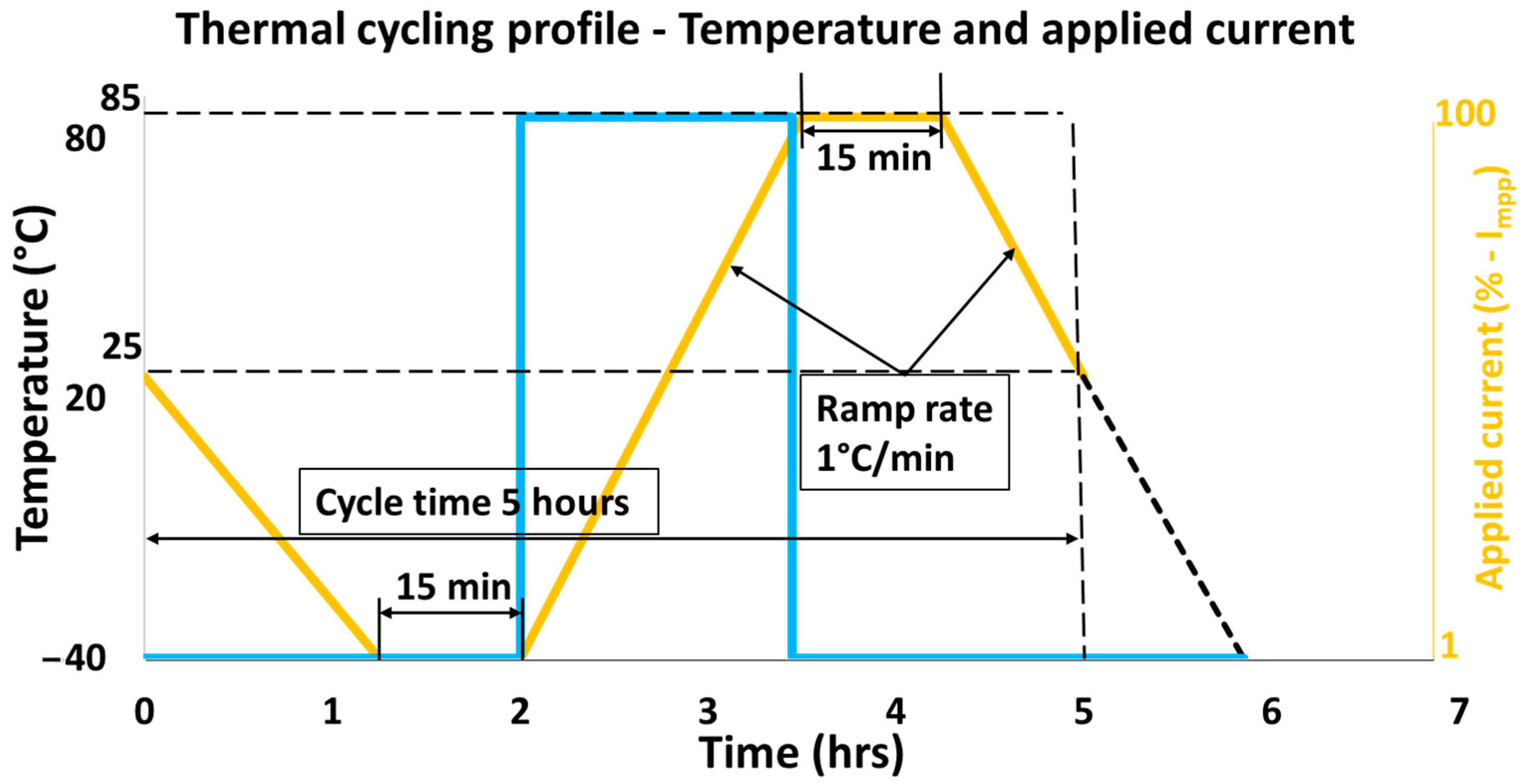

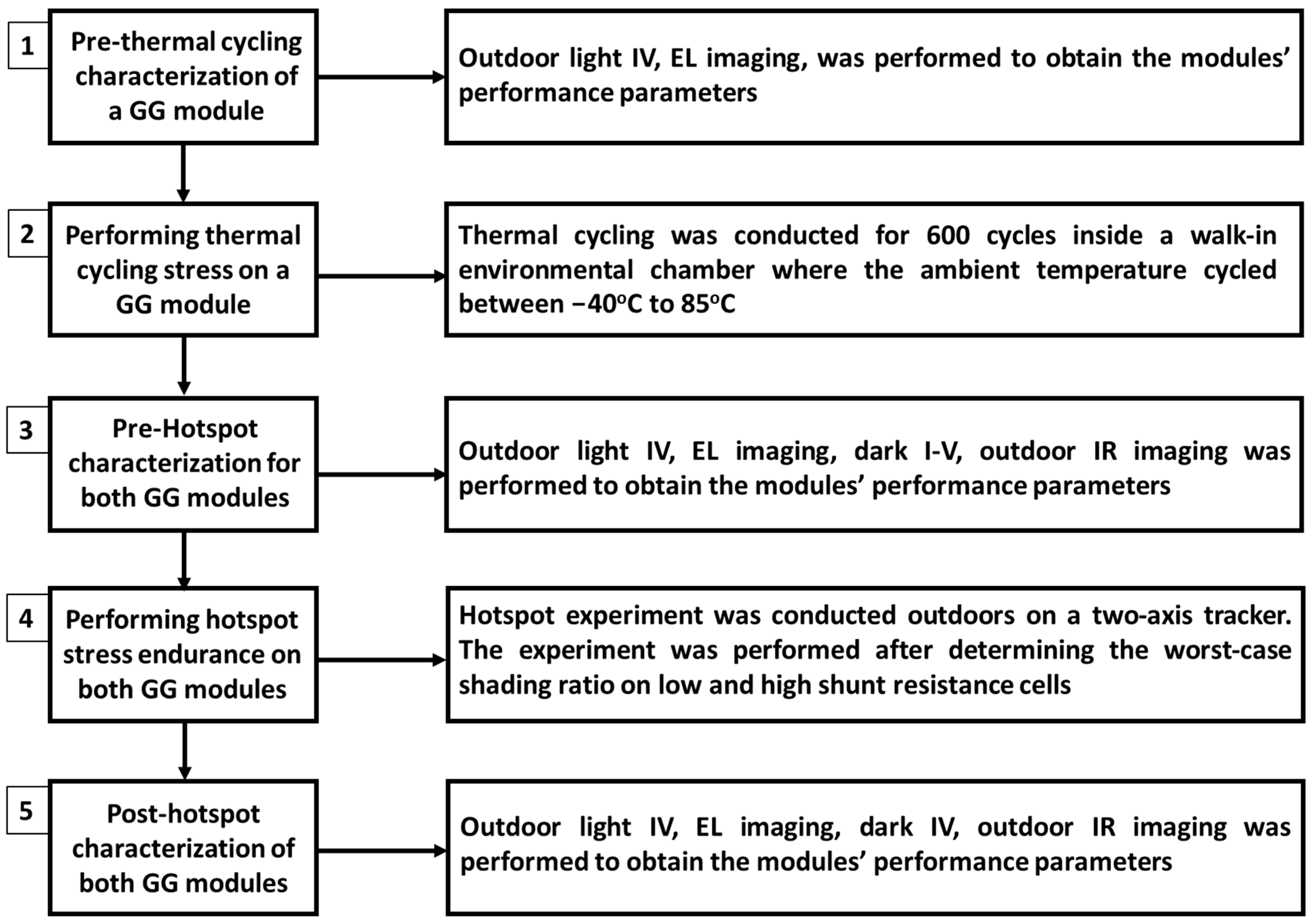

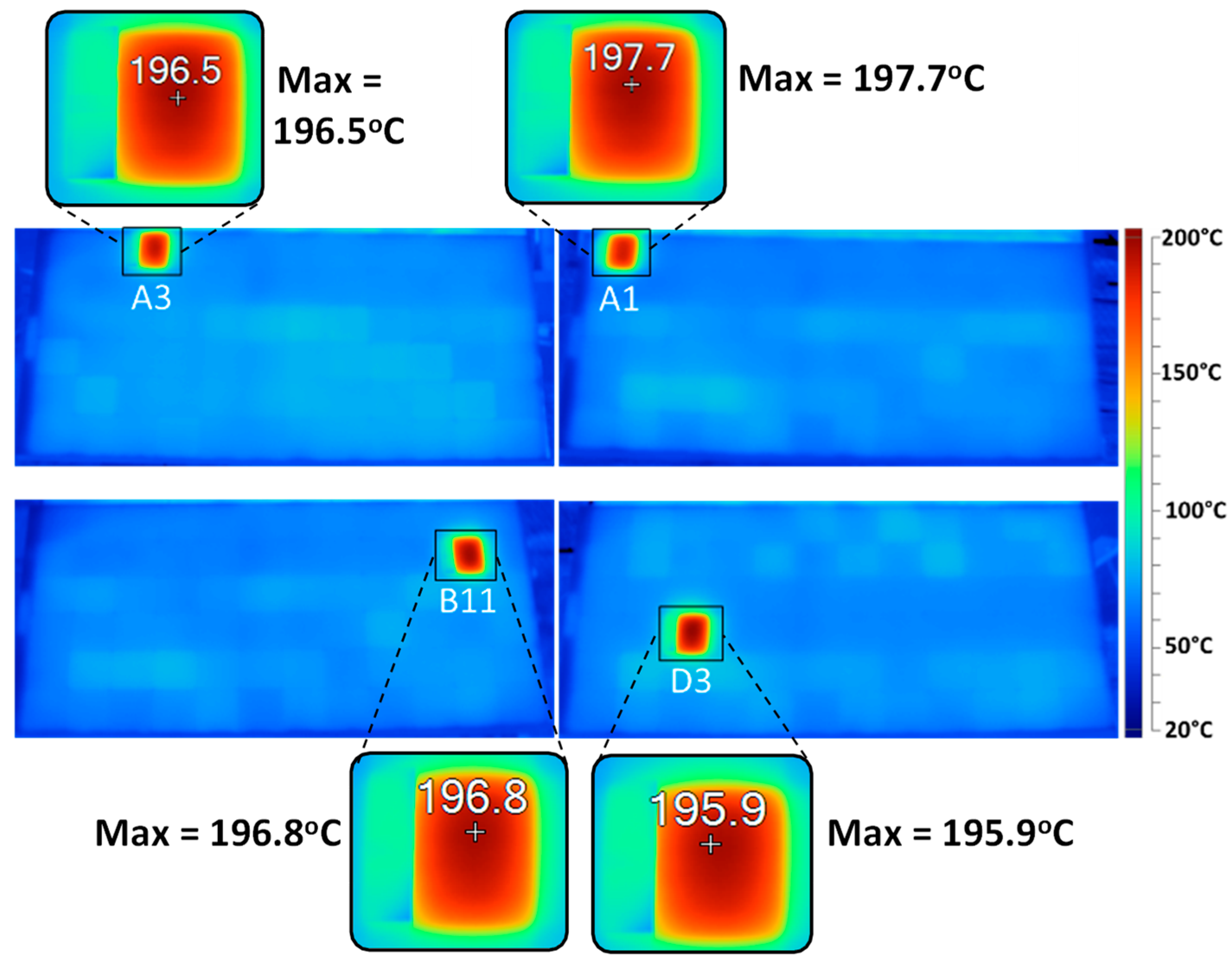




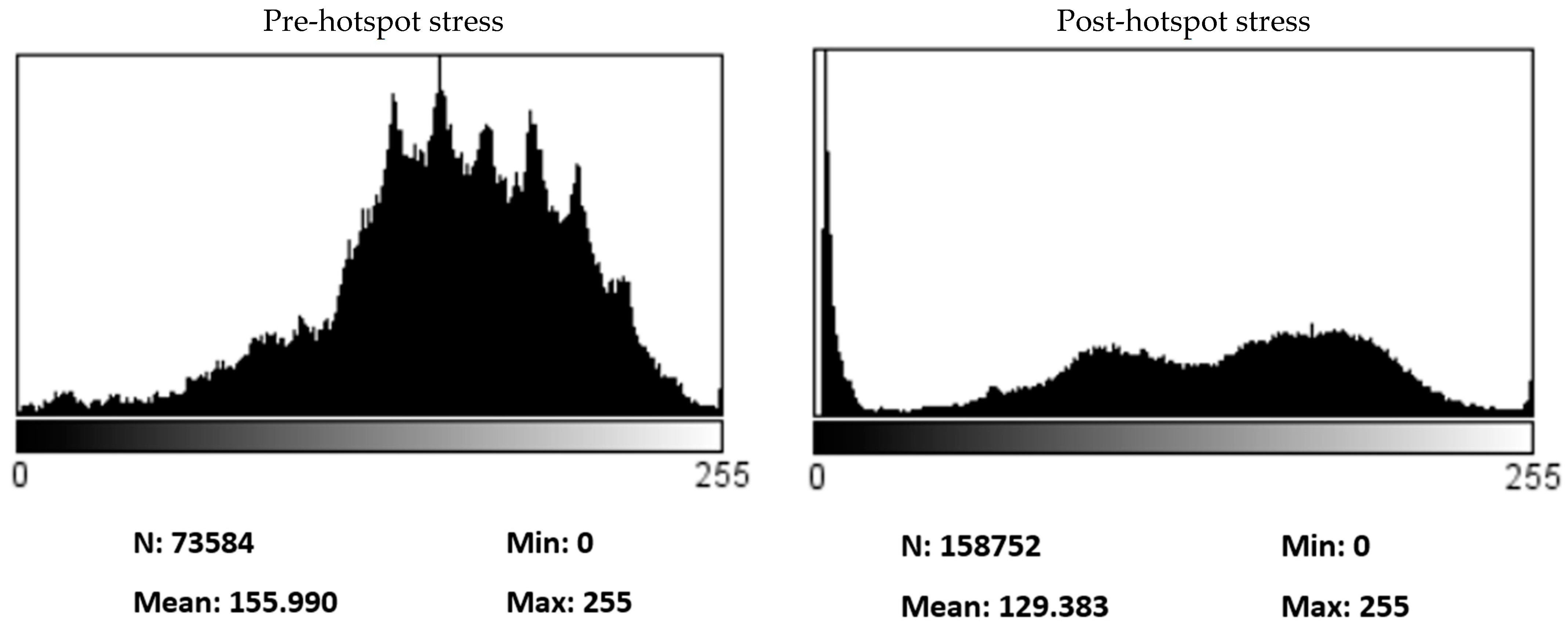
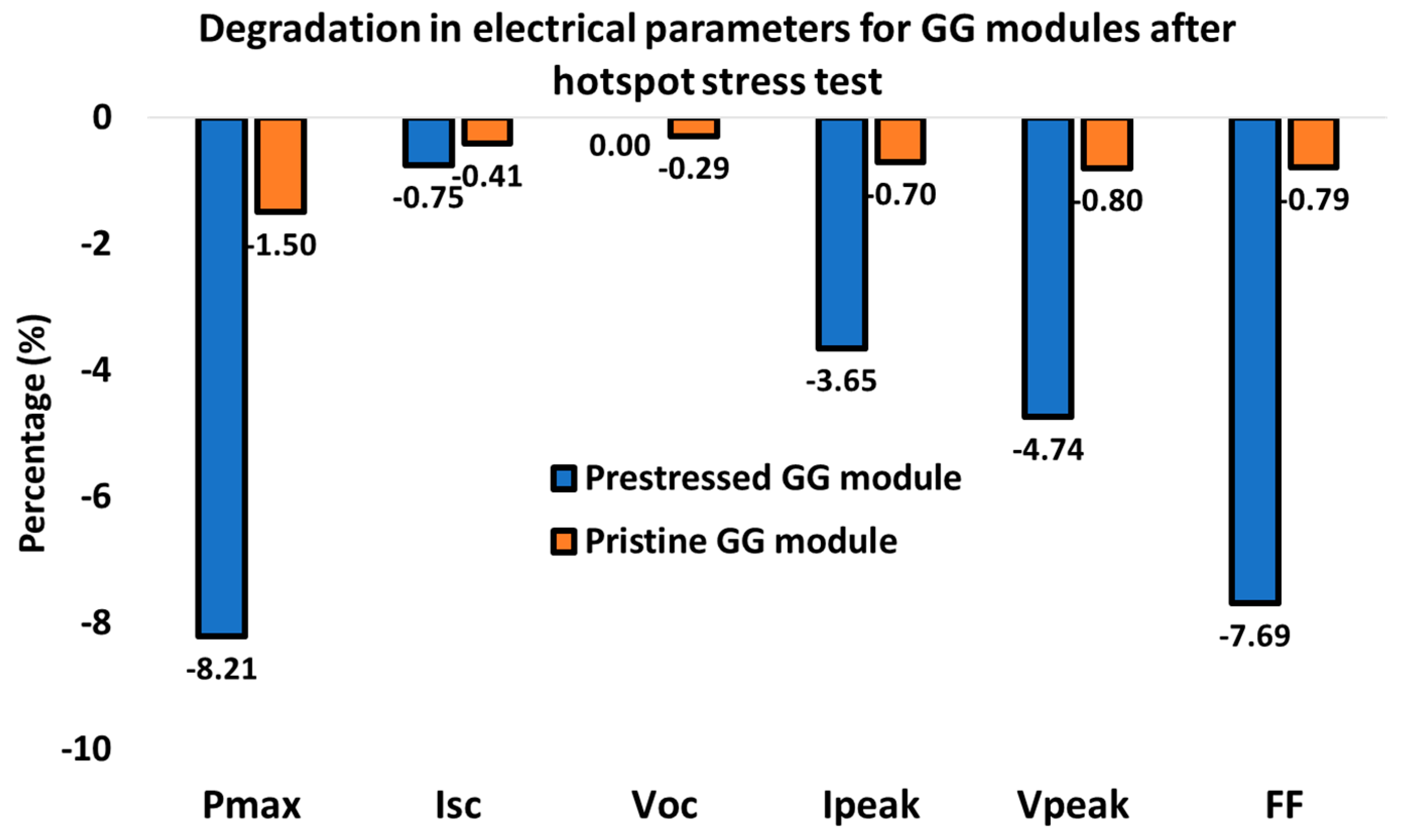
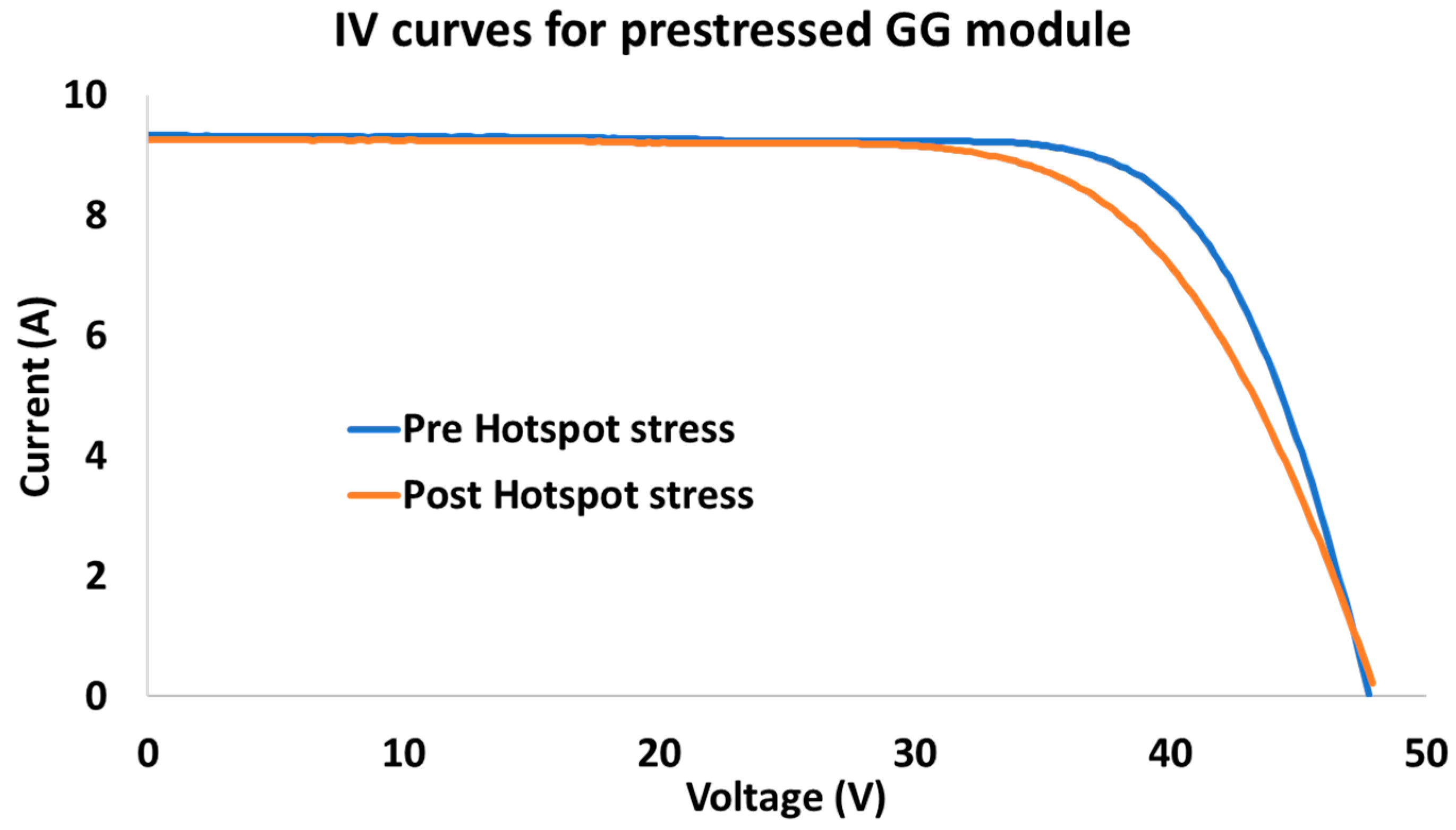
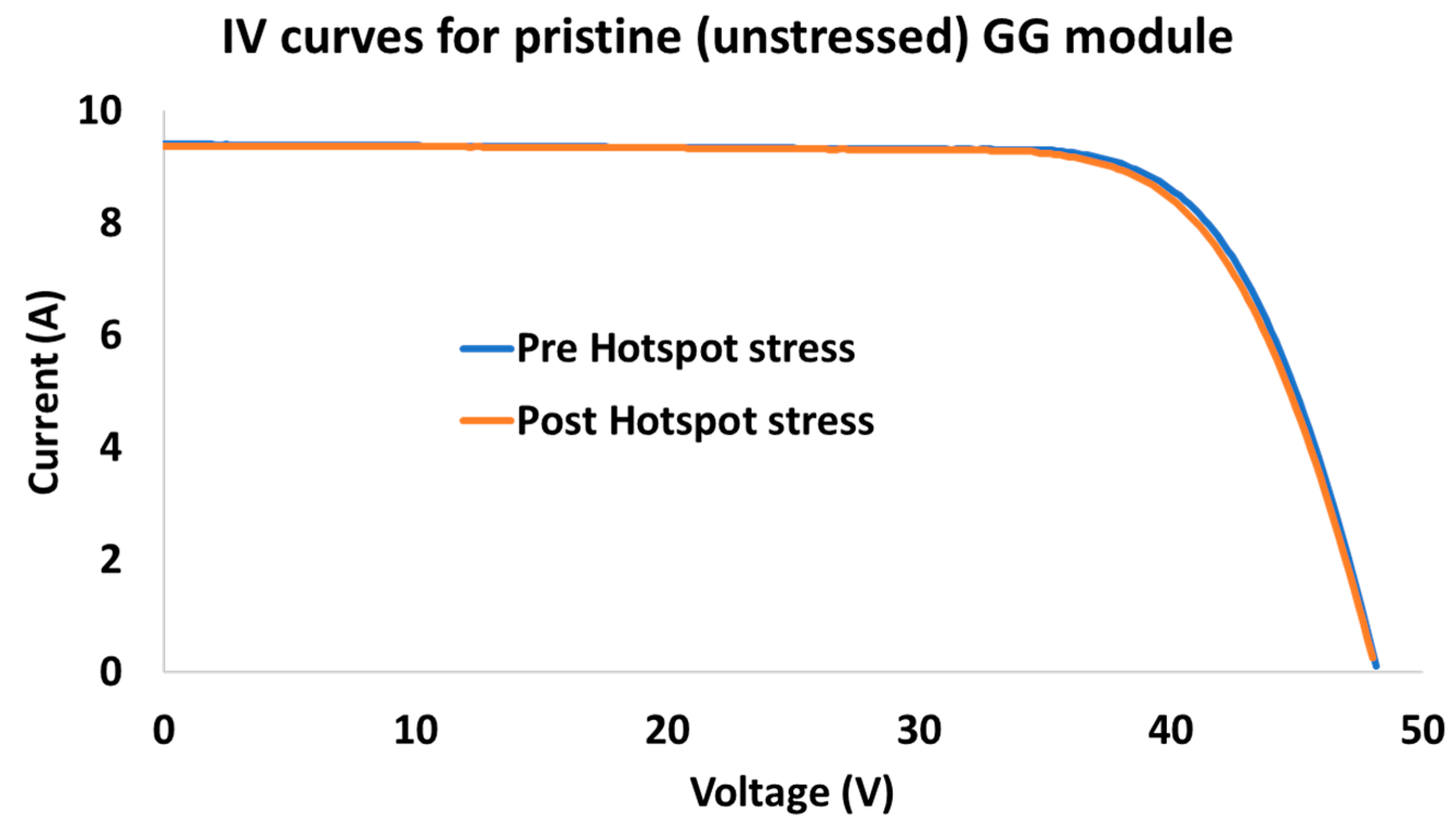
Disclaimer/Publisher’s Note: The statements, opinions and data contained in all publications are solely those of the individual author(s) and contributor(s) and not of MDPI and/or the editor(s). MDPI and/or the editor(s) disclaim responsibility for any injury to people or property resulting from any ideas, methods, instructions or products referred to in the content. |
© 2023 by the authors. Licensee MDPI, Basel, Switzerland. This article is an open access article distributed under the terms and conditions of the Creative Commons Attribution (CC BY) license (https://creativecommons.org/licenses/by/4.0/).
Share and Cite
Afridi, M.; Kumar, A.; Mahmood, F.i.; TamizhMani, G. Comparative Analysis of Hotspot Stress Endurance in Pristine and Thermal Cycled Prestressed Glass–Glass Photovoltaic Modules. Sustainability 2023, 15, 12131. https://doi.org/10.3390/su151612131
Afridi M, Kumar A, Mahmood Fi, TamizhMani G. Comparative Analysis of Hotspot Stress Endurance in Pristine and Thermal Cycled Prestressed Glass–Glass Photovoltaic Modules. Sustainability. 2023; 15(16):12131. https://doi.org/10.3390/su151612131
Chicago/Turabian StyleAfridi, Muhammad, Akash Kumar, Farrukh ibne Mahmood, and GovindaSamy TamizhMani. 2023. "Comparative Analysis of Hotspot Stress Endurance in Pristine and Thermal Cycled Prestressed Glass–Glass Photovoltaic Modules" Sustainability 15, no. 16: 12131. https://doi.org/10.3390/su151612131
APA StyleAfridi, M., Kumar, A., Mahmood, F. i., & TamizhMani, G. (2023). Comparative Analysis of Hotspot Stress Endurance in Pristine and Thermal Cycled Prestressed Glass–Glass Photovoltaic Modules. Sustainability, 15(16), 12131. https://doi.org/10.3390/su151612131





